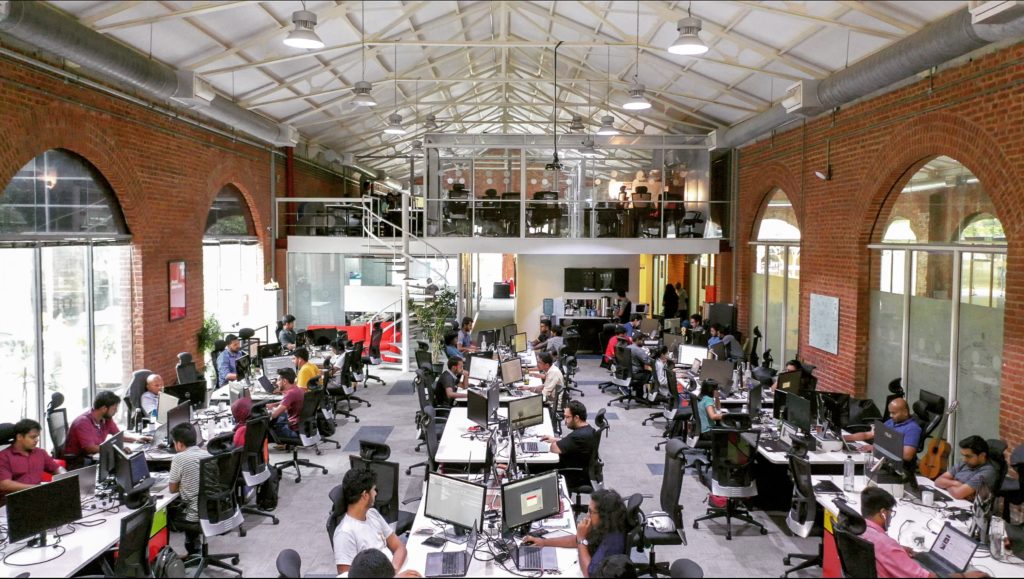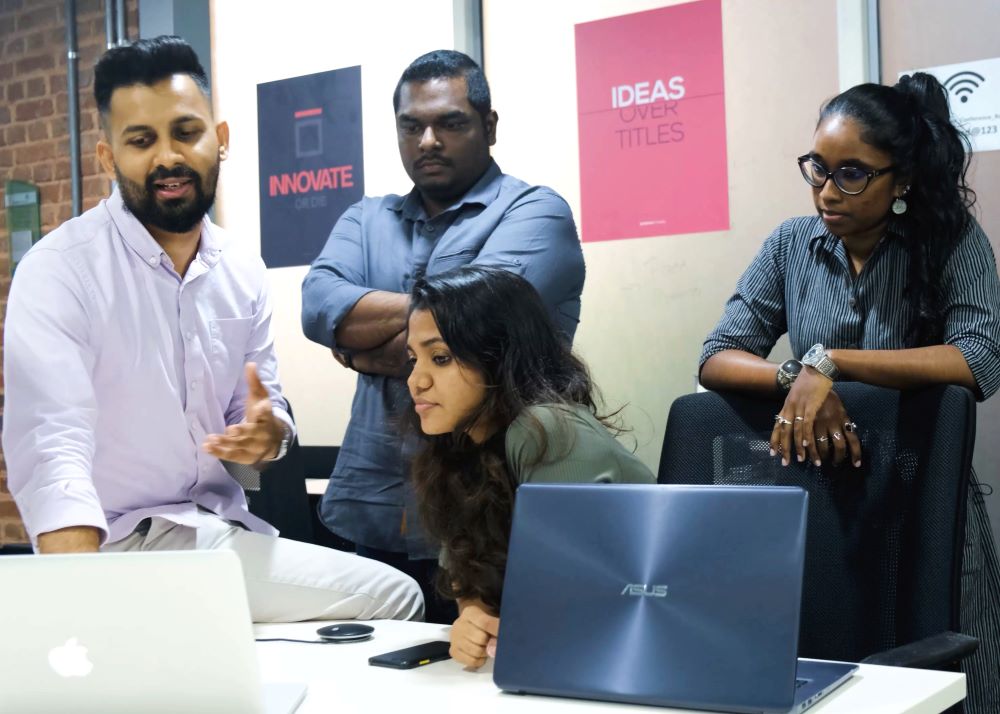What makes a company a great place to work? The question may prompt varying answers depending on your own expectations. But a common understanding is that for a work environment to be a “great place”, it comes down to how accommodating a company is to its employees and the business it’s in. Contributing factors often include culture, great pay, ease of communication, having the right support structure, and a whole lot more. But for the likes of Calcey Technologies, a Great Place To Work goes far beyond a mere marketing tagline.
Back when Mangala Karunaratne set up Calcey, the idea was to replicate the Silicon Valley culture in Sri Lanka. This meant building a company with empowered people, flat management structure, pure meritocracy, the whole nine yards. “It’s been a culture that has been growing since 2002”, says Ishara Walpola, Head of HR at Calcey.
The essence of culture
After all, culture is never just about having a cool workplace with perks and fun. According to Karunaratne, one important element of inculcating a meaningful culture is emphasizing on the “satisfaction” of the work you do. “At the end of the day, if you’re not satisfied with your contributions, perks and fun will hardly matter”, says Karunaratne.
But what’s so great about the culture at Calcey? If you ask someone like Premuditha, a software architect who has been part of the company for eight years, he will attribute the company’s culture to,
- The people
- Emphasis on talent and skills as opposed to paper qualifications
- Ripe opportunities for everyone
As Gehan Dias, General Manager at Calcey puts it, “the only asset in an organization is its people. So investing time and effort in our people is vital to us.”

When it comes to the services industry, particularly with a large-scale operation, those businesses tend to come with a particular type of culture. This type of setting makes it difficult for an entity to focus on the individual, mentions Dias when talking about company culture. Calcey on the other hand, is a boutique operation. In other words, a small but high-end firm. “This gives us the flexibility to focus on the individual.” Why? Because ensuring employees feel empowered and enjoy the work they put in is crucial in meeting the demands of a high-end clientele.
Similarly, it’s also important to be as accommodating to teams as much as possible. This is why Calcey conducts regular surveys and makes changes accordingly. Even its current strategy of a semi-WFH routine was following the majority request to do so. This approach trickles down to other parts of the business as well. For instance, Senior Software Engineers like Sasanka, who joined as a trainee, had the flexibility and freedom that enabled her to both contribute to the company and complete her undergraduate studies in flying colors. As she puts it, “In the end, what matters is that you get the work done properly”.
Enabling internal growth
This sense of Silicon Valley culture embedded in a Sri Lankan company extends to everyone including new hires. One way of ensuring the right fit is during the induction phase itself. “At a scrum meeting, imagine if there are opposing viewpoints from senior architects and junior architects. Whose opinion are you going to value?”, this is a question Walpola often asks new interns during induction. The expectation is that employees would point to listening to both viewpoints and making a judgment afterward. It’s one of the many simple checks and balances in place to push the right people through to the company.
Another area that the company actively looks at is facilitating growth internally. As per Eranjan—a project manager at Calcey, processes set within the company allow for even junior staff members to progress up the ladder. This in turn means that those in senior teams will have the opportunity to move to other teams and focus on different things. The rotation enables the workforce to gain better experience and skillsets as a result.
The importance of maintaining a flat hierarchy
Taking a flat structure, open culture approach will always enable better communication and offer better accessibility within the organization. The simple idea is that even a newly assigned intern should be able to reach out to the senior management as and when needed. This isn’t a novel idea and is quite common in startups with 20-30 team members. But it becomes a challenging task when the team grows beyond 100.
For Calcey however, now a company with over 170 members, it’s part and parcel of the company experience from the early days. As Eranjan and Sasanka will tell you, whether it’s inquiring your team lead about an issue or reaching out to Mangala for assistance, you’re only a text or an email away.

Even when it comes to aspects such as performance evaluation this flat structure is still retained. According to Eranjan, your performance not only gets evaluated by your superiors, but you get feedback from your subordinates as well. The result? An open culture with little to no office politics.
No bullshit
This gets into another important aspect of Calcey’s approach, which is a strict “no corporate drama” policy. Most of us are probably all too familiar with how office politics and bureaucracy often hinder our professional prospects. Calcey consciously avoids it. “We don’t have a tolerance for drama and straight talk is something we expect of each other and encourage at Calcey”, mentions Dias.
Sure, it’s easier said than done. But does it really work? The Calcey team points to some of its senior and mid-level staff members who previously left for other opportunities but eventually came back to Calcey for the simple reason that they didn’t want to deal with the typical corporate bureaucracy.
Growing the team amidst covid
Prior to the pandemic, one of the suggestions from the Calcey team was a request to work from home. As such, processes were set in place to make that possible. So when Covid-19 hit, Calcey was able to deploy WFH arrangements almost overnight.
Of course, that’s not to say Calcey is without its challenges. Like many companies, adjusting to the Covid-19 situation has been tricky. While working from home offers convenience like never before, it also limits the physical and social experience of being part of a vibrant work environment.

This is where it’s important to be as accommodating as possible. For Calcey, this partly meant making the home work environment comfortable. According to Ishara Walpola, Head of HR at Calcey, “we reimbursed employees for their working desks and chairs. Some actually preferred the ones at office. So we even delivered those to homes.”
Another part of tackling a remote working arrangement is having a welcoming environment for employees. Particularly new team members. “We make it a point to announce newly joined members, and not just their professional profile either”. It’s a simple gesture, one that gets teams engaging with recruits from the get-go.
Adding to that comes the various administrative tasks. “We already have the systems in place. So documentation around HR matters can be handled online in its entirety”, says Walpola. Again, convenience.
An operating model that works
Not every operating model is adaptable and works in favor of the workforce, especially in the tech space. One of the more popular mechanisms is the “bodyshopping” model, where developers are left to work with clients directly with limited support from the company. While this can potentially expose you to more experiences, it can also leave developers with more stress and extra workload.
Calcey’s managed model structure looks to circumvent this problem. It enables the company to build its teams around specific capabilities while offering that much-needed flexibility and support structure. To put it in another way, the model is essentially tweaked to enable everyone to do what they are good at.
Culture fit with the clientele
Of course, for a company that operates on a managed team model, fostering business relationships with varying cultural considerations is another focal point. This means ensuring that your workforce is the right culture fit is almost as important as the set of skills and experience you bring to the table.
Though it certainly doesn’t help when conflict avoidance is something that our part of the world strives for. This is one reason why we tend to see a lot of project management and business analyst roles at tech companies. Communication focal points are needed, “But if you take a Swedish firm, for example, you’ll see developers not only handle the workload but actively engage with the client and conduct other tasks”.
So how does Calcey navigate this? Bridging the gap to address the communication focal points requires building balanced teams as opposed to individuals. For a boutique firm, it’s a matter of the right set of personalities and attitudes. “Because trying to get all the individuals to havethe same culture fit with another market is unlikely”, says Dias. “So our PMs tend to mediate cultures, by being proactive and resolving conflicts head-on”, Dias states further.
Commitment to excellence
Mind you, culture fit alone won’t do the job. Particularly when you’re dealing with Silicon Valley-level clientele. Ensuring high technical standards is part of the package. For Calcey, its commitment to excellence has paid dividends for the company over the years. As of now, over 90% of Calcey’s current clientele are referrals from past clients. Not something every company with decades of history can claim.
What it is to be a Great Place To Work
So there you have it, a glimpse of what it is to be a great place to work through the eyes of Calcey Technologies. As a tech company that specializes in niches ranging from fintech to enterprise SaaS, the pandemic only served to emphasize the need for the right culture and approach for a business to operate successfully. Calcey is an apt example.
The prospect of Calcey’s approach has been rewarding for the company, particularly as of late. In 2021 alone, Calcey grew from 115 to 170+ employees. It recorded its best performance ever as a company, doubling in size over the last two years.





GIPHY App Key not set. Please check settings